7 books about Outsiders in literature
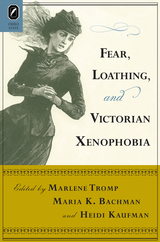
Fear, Loathing, and Victorian Xenophobia
Marlene Tromp, Maria Bachman, and Heidi Kaufman
The Ohio State University Press, 2013
In this groundbreaking collection, scholars explore Victorian xenophobia as a rhetorical strategy that transforms “foreign” people, bodies, and objects into perceived invaders with the dangerous power to alter the social fabric of the nation and the identity of the English. Essays in the collected edition look across the cultural landscape of the nineteenth century to trace the myriad tensions that gave rise to fear and loathing of immigrants, aliens, and ethnic/racial/religious others. This volume introduces new ways of reading the fear and loathing of all that was foreign in nineteenth-century British culture, and, in doing so, it captures nuances that often fall beyond the scope of current theoretical models. “Xenophobia” not only offers a distinctive theoretical lens through which to read the nineteenth century; it also advances and enriches our understanding of other critical approaches to the study of difference. Bringing together scholarship from art history, history, literary studies, cultural studies, women’s studies, Jewish studies, and postcolonial studies, Fear, Loathing, and Victorian Xenophobia seeks to open a rich and provocative dialogue on the global dimensions of xenophobia during the nineteenth century.
[more]
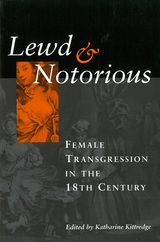
Lewd and Notorious
Female Transgression in the Eighteenth Century
Katharine Kittredge, Editor
University of Michigan Press, 2003
Accounts of women's transgressive behavior in eighteenth-century literature and social documents have much to teach us about constructions of femininity during the period often identified as having formed our society's gender norms. Lewd and Notorious explores the eighteenth century's shadows, inhabited by marginal women of many kinds and degrees of contrariness. The reader meets Laetitia Pilkington, whose sexual indiscretions caused her to fall from social and literary grace to become an articulate memoirist of personal scandal, and Elizabeth Brownrigg, who tortured and starved her young servants, propelling herself to an infamy comparable to Susan Smith's or Myra Hindley's. More awful women wait between these covers to teach us about society's reception (and construction) of their debauchery and dangerousness.
The authors draw upon a rich range of contemporary texts to illuminate the lives of these women. Astute analysis of literary, legal, evangelical, epistolary, and political documents provides an understanding of 1700s womanhood. From lusty old maids to murderous mistresses, the characters who exemplify this period's vision of women on the edge are essential acquaintances for anyone wishing to understand the development and ramifications of conceptions of femininity.
[more]
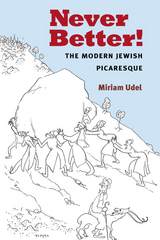
Never Better!
The Modern Jewish Picaresque
Miriam Udel
University of Michigan Press, 2016
It was only when Jewish writers gave up on the lofty Enlightenment ideals of progress and improvement that the Yiddish novel could decisively enter modernity. Animating their fictions were a set of unheroic heroes who struck a precarious balance between sanguinity and irony that author Miriam Udel captures through the phrase “never better.” With this rhetorical homage toward the double-voiced utterances of Sholem Aleichem, Udel gestures at these characters’ insouciant proclamation that things had never been better, and their rueful, even despairing admission that things would probably never get better.
The characters defined by this dual consciousness constitute a new kind of protagonist: a distinctively Jewish scapegrace whom Udel denominates the polit or refugee. Cousin to the Golden Age Spanish pícaro, the polit is a socially marginal figure who narrates his own story in discrete episodes, as if stringing beads on a narrative necklace. A deeply unsettled figure, the polit is allergic to sentimentality and even routine domesticity. His sequential misadventures point the way toward the heart of the picaresque, which Jewish authors refashion as a vehicle for modernism—not only in Yiddish, but also in German, Russian, English and Hebrew. Udel draws out the contours of the new Jewish picaresque by contrasting it against the nineteenth-century genre of progress epitomized by the Bildungsroman.
While this book is grounded in modern Jewish literature, its implications stretch toward genre studies in connection with modernist fiction more generally. Udel lays out for a diverse readership concepts in the history and theory of the novel while also explicating the relevant particularities of Jewish literary culture. In addressing the literary stylistics of a “minor” modernism, this study illuminates how the adoption of a picaresque sensibility allowed minority authors to write simultaneously within and against the literary traditions of Europe.
The characters defined by this dual consciousness constitute a new kind of protagonist: a distinctively Jewish scapegrace whom Udel denominates the polit or refugee. Cousin to the Golden Age Spanish pícaro, the polit is a socially marginal figure who narrates his own story in discrete episodes, as if stringing beads on a narrative necklace. A deeply unsettled figure, the polit is allergic to sentimentality and even routine domesticity. His sequential misadventures point the way toward the heart of the picaresque, which Jewish authors refashion as a vehicle for modernism—not only in Yiddish, but also in German, Russian, English and Hebrew. Udel draws out the contours of the new Jewish picaresque by contrasting it against the nineteenth-century genre of progress epitomized by the Bildungsroman.
While this book is grounded in modern Jewish literature, its implications stretch toward genre studies in connection with modernist fiction more generally. Udel lays out for a diverse readership concepts in the history and theory of the novel while also explicating the relevant particularities of Jewish literary culture. In addressing the literary stylistics of a “minor” modernism, this study illuminates how the adoption of a picaresque sensibility allowed minority authors to write simultaneously within and against the literary traditions of Europe.
[more]

Searching for Safe Spaces
Afro-Caribbean Women Writers in Exile
Myriam Chancy
Temple University Press, 1997
Home. Exile. Return. Words heavy with meaning and passion. For Myriam Chancy, these three themes animate the lives and writings of dispossessed Afro-Caribbean women.
Understanding exile as flight from political persecution or types of oppression that single out women, Chancy concentrates on diasporic writers and filmmakers who depict the vulnerability of women to poverty and exploitation in their homelands and their search for safe refuge. These Afro-Caribbean feminists probe the complex issues of race, nationality, gender, sexuality, and class that limit women's lives. They portray the harsh conditions that all too commonly drive women into exile, depriving them of security and a sense of belonging in their adopted countries -- the United States, Canada, or England.
As they rework traditional literary forms, artists such as Joan Riley, Beryl Gilroy, M. Noubese Philip, Dionne Brand, Makeda Silvera, Audre Lorde, Rosa Guy, Michelle Cliff, and Mari Chauvet give voice to Åfro-Caribbean women's alienation and longing to return home. Whether their return is realized geographically or metaphorically, the poems, fiction, and film considered in this book speak boldly of self-definition and transformation.
Understanding exile as flight from political persecution or types of oppression that single out women, Chancy concentrates on diasporic writers and filmmakers who depict the vulnerability of women to poverty and exploitation in their homelands and their search for safe refuge. These Afro-Caribbean feminists probe the complex issues of race, nationality, gender, sexuality, and class that limit women's lives. They portray the harsh conditions that all too commonly drive women into exile, depriving them of security and a sense of belonging in their adopted countries -- the United States, Canada, or England.
As they rework traditional literary forms, artists such as Joan Riley, Beryl Gilroy, M. Noubese Philip, Dionne Brand, Makeda Silvera, Audre Lorde, Rosa Guy, Michelle Cliff, and Mari Chauvet give voice to Åfro-Caribbean women's alienation and longing to return home. Whether their return is realized geographically or metaphorically, the poems, fiction, and film considered in this book speak boldly of self-definition and transformation.
[more]
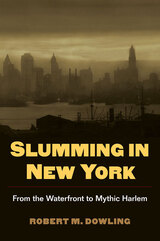
Slumming in New York
From the Waterfront to Mythic Harlem
Robert M. Dowling
University of Illinois Press, 2006
This remarkable exploration of the underbelly of New York City life from 1880 to 1930 takes readers through the city's inexhaustible variety of distinctive neighborhood cultures. Slumming in New York samples a number of New York "slumming" narratives--including Stephen Crane's Bowery tales, Paul Laurence Dunbar's The Sport of the Gods, Hutchins Hapgood's The Spirit of the Ghetto, Jacob Riis's How the Other Half Lives, and Carl Van Vechten's Nigger Heaven--to characterize and examine the relationship between New York writing and the city's cultural environment.
Using the methods of ethnicity theory, black studies, regional studies, literary studies, and popular culture, Robert M. Dowling reveals the way in which "outsider" authors helped alleviate New York's mounting social anxieties by popularizing "insider" voices from neighborhoods as distinctive as the East Side waterfront, the Bowery, the Tenderloin's "black Bohemia," the Jewish Lower East Side, and mythic Harlem.
[more]

Society and its Outsiders in the Novels of Jakob Wassermann
Katharina Volckmer
University of London Press, 2016
Society and its Outsiders in the Novels of Jakob Wassermann takes a fresh look at Wassermann’s depiction of society and its mechanisms of exclusion, specifically those affecting the Jew, the woman, the child and the homosexual man. Wassermann’s extensive oeuvre has not, until now, been considered as an attempt to portray German society at different historical stages, from the Biedermeier to the end of the Weimar Republic. At the same time, this analysis shows how Wassermann’s interest in outsider figures is intertwined with an interest in narrative technique and discusses how his perception of the world affects his depiction of character.
[more]
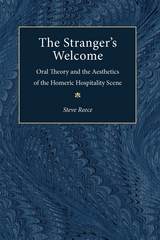
The Stranger's Welcome
Oral Theory and the Aesthetics of the Homeric Hospitality Scene
Steve Reece
University of Michigan Press, 1993
Examination of the tension between oral composition and poetic creativity
[more]
READERS
Browse our collection.
PUBLISHERS
See BiblioVault's publisher services.
STUDENT SERVICES
Files for college accessibility offices.
UChicago Accessibility Resources
home | accessibility | search | about | contact us
BiblioVault ® 2001 - 2024
The University of Chicago Press









